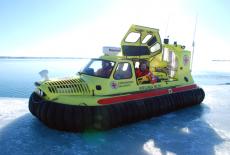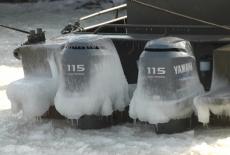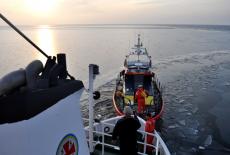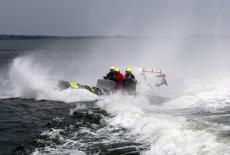SMACS - A Safer Arctic For Small Craft Mariners

02.12.2013
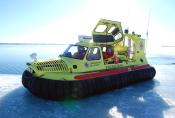
Climate change is making ever larger areas of the Arctic maritime region accessible for small craft in the fishing, tourism and leisure sectors. However, the Arctic still remains a hazardous region for inadequately prepared mariners.
Climate change is altering weather and ice patterns and creating new dangers for all mariners in the region. Growing large vessel activity in the tourism, cargo, mining and oil exploration sectors presents additional hazards to the safe navigation of small craft.
There is therefore an urgent need for safety and emergency response training for Arctic mariners. However, while such training is regulated and widely available for large vessel crew, this is not the situation for small craft mariners who find it more difficult to access Arctic-specific training.
The SMACS Project aims to fill this gap and make the Arctic a safer location for small craft maritime activity by developing a safety and emergency response training programme specifically focused on the needs of small craft mariners.
SMACS: Small Craft Emergency Response and Survival Training for Arctic Conditions is a collaborative international project under the Northern Periphery Programme of the EU and is supported by the European Regional Development Fund. Started October 2012 it is a two-year project and its primary objective is the development of a safety and survival training programme for small-craft Arctic mariners.
The SMACS Training Programme will be made available free of charge to all training providers at the end of the project.
The RIB & HSC Directory is pleased to support the SMACS project
Three of the five SMACS partners are engaged in maritime training (Cork Institute of Technology - Ireland, Chalmers University - Sweden, MSSTC - Iceland) two are Arctic Search and Rescue organisations (SSRS Sweden and NSSR Norway). SMACS also has associated partners in Greenland, Norway, Faroes & Ireland.
In maritime emergencies, fast, efficient responses can make the difference between survival and disaster, especially in the harsh arctic environment. For crew of large vessels, emergency response training is mandatory and training is widely available internationally which includes advanced training using both virtual and practical simulators e.g. for lifeboat launching and fire-fighting.
However, for smaller commercial, fishing and leisure craft, emergency response and survival training is less structured and generally involves less “hands-on” experiential content, with “on-the-job” training by other crew members being the main source of experiential learning. Such small craft are characteristic of the small coastal communities of the NPP Arctic regions where, in addition to the indigenous maritime communities, changing climate is bringing a growing influx of non-indigenous fishing and tourist / leisure craft during the longer summer season.
The rapidly changing Arctic climate brings new challenges in maritime safety for both indigenous and non-indigenous small craft crew. Indigenous maritime safety practices built up over many generations are having to be quickly adapted to climate change. For non-indigenous mariners, the apparently more benign Arctic climate still holds many dangers of which they may have little experience. In turn, Arctic Search and Rescue (SAR) services must deal with a greater number and diversity of small craft emergencies over a much wider geographic range. In addition, within the volunteer- SAR services, where as few as one in ten crew now have a maritime background, putting extra pressure is developing on SAR training, especially for harsh conditions.
For small craft mariners, more structured training, with greater experiential content, in emergency response and survival techniques in Arctic conditions could make the difference between life and death. Formal certification may also increase the employment prospects of indigenous small craft mariners in the Arctic.
However, such training for small craft mariners in Arctic conditions presents a number of major challenges:-
(a) The time and financial budgets of small craft mariners will typically be smaller than for mariners on large commercial vessels.
(b) It should be possible to deliver the training locally, in one or more locations in each region, within the resource and financial budgets of local training organisations.
(c) Mariner training methods appropriate for crew of larger vessels in less harsh climates have to be adapted to both the harsh climatic conditions and to the unique physiological stresses imposed on mariners by these conditions.
SMACS will address these challenges by combining transnational expertise in both maritime training and SAR with expertise in advanced technologies for enhancement of training of mariners and SAR crews.
See SMACS Further Information
To achieve its target of making the Arctic a safer place for small craft mariners SMACS need input from all stakeholders with interest in small craft safety & survival:-
- Native Arctic small craft mariners in fishing / commercial /'tourism / leisure sectors
- Native Arctic small craft mariners who use small craft as part of their way of life
- Small craft mariners from any location visiting Arctic regions for any purposes
- Maritime training providers
- Search and rescue personnel
- Mariners representative organisations
- Maritime policy makers
- Providers of maritime safety and survival equipment
See SMACS Arctic Survey
Erik the Red
Erik the Red is a character in the Icelandic sagas who is reputed to have sailed to Greenland and to North America (Vinland). As Erik the Red was one of the first recorded Arctic small-craft mariners. The 1875 painting by Carl Rasmussen of Erik the Red arriving in Greenland has been selected as the emblem of SMACS.
Highlighting the dangers of sailing in Arctic waters Rasmussen was drowned in 1893 on a voyage home from Greenland when he fell overboard from the brig Peru, apparently while painting at his easel.
Photos copyright of SSRS / Captain Fredrik Forsman / Jaako Pitkajarvi
All images are copyright RIB & HSC 2024 unless otherwise stated.
This does not exclude the owner's assertion of copyright over the material.
05.04.2024
Hydro Motion - H2 from NL to England in 2024
The TU Delft Hydro Motion Team wants to cross to…
05.01.2024
The Challenges of Unpredictable Marine Energy
From military to superyacht, it is clear there is an urgent…
Speed@Seawork 2024
Dates:
10th June 2024
Location:
Cowes, Isle Of Wight,
Foiling and Flying RIBs
Foiling powerboat designed to meet military needs - fast, stable, silent, fuel-saving. Collaboration by SEAir Foiling Systems and Sillinger RIBs.…














